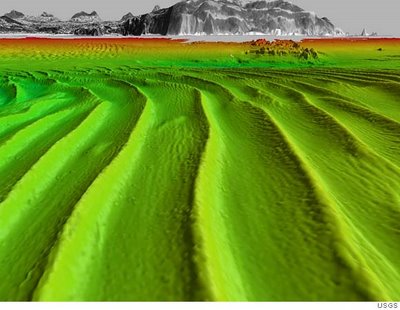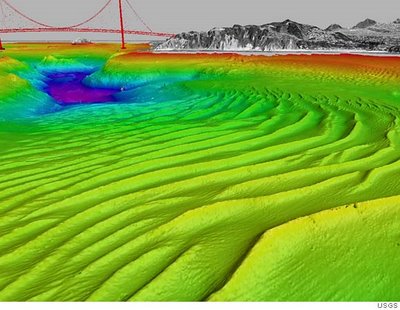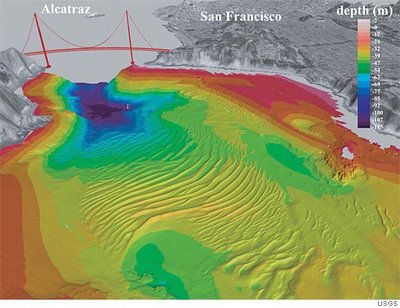The Dune Sea
 From today's San Francisco Chronicle: "'These are some of the largest sand waves in the world,' said Patrick Barnard, a coastal geologist with the Santa Cruz office of the U.S. Geological Survey. 'They're certainly in the upper 10 percent.'"
From today's San Francisco Chronicle: "'These are some of the largest sand waves in the world,' said Patrick Barnard, a coastal geologist with the Santa Cruz office of the U.S. Geological Survey. 'They're certainly in the upper 10 percent.'" Unfortunately – or perhaps more interestingly – they're underwater, lining the bottom of San Francisco Bay like tectonic corrugation: "The sand waves range up to 700 feet long and reach heights of more than 30 feet, Barnard said. It is a dynamic system, he said, with the configuration of the individual dunes changing significantly with each tidal cycle. But overall and over time, the net change to the entire field is slight."
In that regard, and if you were pretentious, you could say that the landscape inhabits a kind of fractal temporality...
 As it is, "scientific interest in sand waves has been growing around the world because sonar technology has improved to the point that high resolution, three-dimensional maps can now be made of the ocean's floor" – which was actually explored in an earlier post on BLDGBLOG: The Geoacoustic Sea.
As it is, "scientific interest in sand waves has been growing around the world because sonar technology has improved to the point that high resolution, three-dimensional maps can now be made of the ocean's floor" – which was actually explored in an earlier post on BLDGBLOG: The Geoacoustic Sea. There we read the following: "It'd be interesting, meanwhile, if you could take geoacoustic data and release it as an MP3: you could then listen to the suboceanic landscape's raw sonic topography, compressed aquatic echoes, complete with deepsea ridges and audio-thermal vents. Non-visual mapping of unreachable landscapes. An MP3 of the surface of Mars. The rings of Saturn."
There we read the following: "It'd be interesting, meanwhile, if you could take geoacoustic data and release it as an MP3: you could then listen to the suboceanic landscape's raw sonic topography, compressed aquatic echoes, complete with deepsea ridges and audio-thermal vents. Non-visual mapping of unreachable landscapes. An MP3 of the surface of Mars. The rings of Saturn."And now we've read it again – because, for the record, I still think it'd be interesting. After all, if you can't actually visit the landscape, you could simply download it as an MP3... Audio geotechnics. Or convective audio cartographies, 3D podcasts of unexplored worlds.
(Thanks to Bryan for the tip!)





Comments are moderated.
If it's not spam, it will appear here shortly!
Geoff,
It is a small point, but the waves are outside the Bay rather than "lining to bottom" of it.
Hey Jack - Small point but good point. Thanks for the correction -
emailed this but thought I'd post too for good measure. Don't think you've posted about it before, and I think you'll appreciate! :)
http://www.theregister.co.uk/2006/07/19/huangyangtan_mystery/
just fyi, you can in fact listen to mp3s of saturn:
http://saturn.jpl.nasa.gov/multimedia/sounds/
Aye Cap'n. Those rumble strips would make some interesting noises as the ocean grinds to a halt.
ooops, OK, just saw it on Pruned, never mind... ^_^
Post a Comment